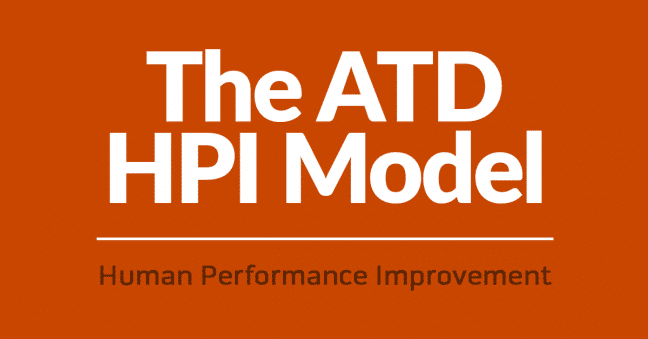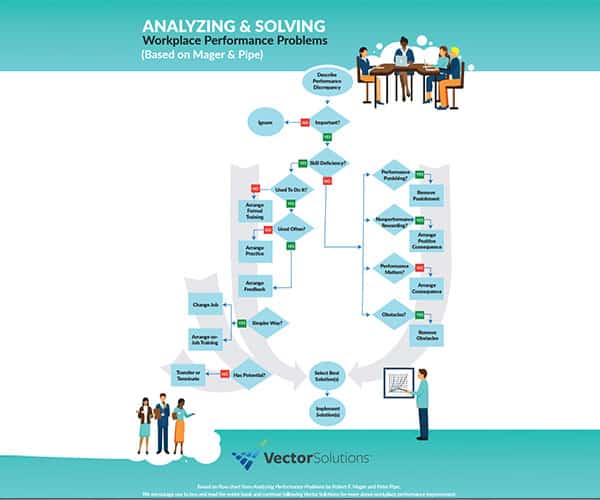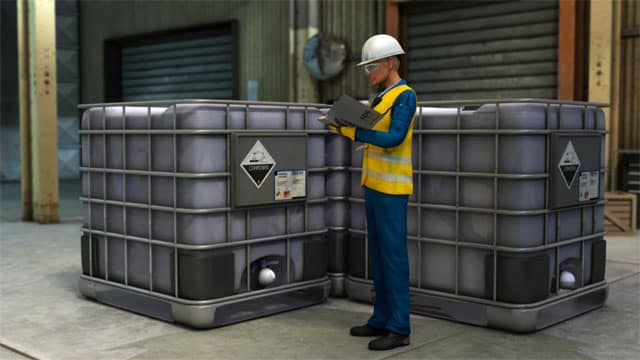July 8, 2020 5 min read

The ATD Human Performance Improvement (HPI) Model
Industry:
Solution:

Vector Solutions isn’t just a training company. Instead, we’re devoted to helping organizations with a variety of performance improving solutions to increase efficiency, decrease waste, and improve profits, opportunities, innovation, learning, and successes.
As a result, we’re not just interested in training (although we do always keep a strong focus on evidence-based training methods), but in addition we’re interested in human performance improvement–also called HPI (check out our recorded What Is Human Performance Improvement video discussion and our upcoming Why Apply HPI? webinar, for example).
That said, there’s some understandable confusion about Human Performance Improvement (HPI). For example, the Association for Talent Development (ATD) has an HPI model, the International Society for Performance Improvement (ISPI) offers a Certified Performance Technician workshop and certification (note the minor name change there–you’ll see human performance technology from time-to-time as well), and the US Department of Energy offers a two-volume Human Performance Improvement Handbook (this is often associated with nuclear safety and the Institute of Nuclear Power Operations, or INPO).
To tell you the truth, I got a little confused just typing all that up.
And then to add to the confusion, HPI has quite a bit in common with some “new views” on occupational safety, such as Safety Differently, Safety II, and Human and Organizational Performance (HOP) as well as with workplace performance analysis, managerial, organizational development, and organizational learning theories and strategies.
But the GOOD NEWS here is those different versions of HPI from different organizations, those new views on occupational safety, and those other management, organizational development, and organizational learning theories share more in common than they differ. If you Venn-diagrammed all this out, there would be a lot of overlap.
In THIS article, we’re going to give you a brief overview of the ATD HPI model, while of course we encourage you to go over to ATD’s website and learn more from their HPI materials. Watch for future articles where we explain a little more about some of the other HPI models.

Vector Solutions are manufacturing & industrial training and performance improvement experts. Check out how our solutions can help your organization:
- Learning Management Systems →
- Online Manufacturing Training Courses →
- Safety Management Software Software →
- Mobile Risk Communication Platform →
- More Workplace Performance-Improvement Solutions →
Download our Manufacturing Training Guide
What Is the Definition of Human Performance Improvement (HPI)?
Before we introduce you to the ATD HPI model, let’s take a step back and consider the ATD’s definition of HPI (which is formally credit to William Rothwell, 2000). According to the ATD, human performance improvement is:
…a systematic process of discovering and analyzing important human performance gaps, planning for future improvements in human performance, designing and developing cost-effective and ethically justifiable interventions to close performance gaps, implementing the interventions, and evaluating the financial and non financial results.
Rothwell et al, Human Performance Improvement, 2000
As you see, while HPI can include training, it’s not limited to training by any means and there are many potential interventions.
Human Performance Improvement is Systematic and Systemic
As you’ll see below, HPI is both systematic and systemic.
The fact that there’s a model that presents a repeatable method gives you a hint that HPI is systematic, meaning it gives a structured approach that’s intended to be comprehensive and repeatable instead of merely a shot-in-the-dark or going by your best guess or gut feeling.
And HPI is systemic because it seems a workplace organization as a series of elements that are interrelated. To learn more about this, check out our Systems Thinking for Workplace Performance Improvement article or this Systems View of Human Performance article by Geary Rumler and Alan Brache.
PLUS–HPI Is Evidence & Data-Driven
Another thing to know about human performance improvement is that it is based on evidence and data. You can’t get away with simply “going with your gut” and you can’t just hope an intervention helped. You’ve got to measure and use evidence & data.
The ATD Human Performance Improvement Model
The ATD human performance improvement model involves six steps:
- Performance analysis
- Cause analysis
- Intervention
- Implementation
- Change management
- Evaluation & measurement
Let’s take a slightly closer look at each of these six steps below.
Performance Analysis
During the performance analysis, the HPI professional analyzes the actual performance to better understand the problem. This is often expressed or thought of as a “gap” between the current state and abilities and an ideal state.
Cause Analysis
Once the performance analysis has been completed, the next step of the HPI model is to analyze the cause of the performance problem. d
Intervention
Once the HPI practitioner has analyzed the performance, identified a “gap” or problem of some sort, and then further analyzed to discover the cause of that problem, the next step is to come up with one or more appropriate interventions to solve that problem.
Note that training MIGHT be an appropriate intervention, but that’s not always the case.
Implementation
After an intervention (or multiple interventions) have been developed, it’s time to implement the intervention.
Change Management
One the intervention has been implemented, the HPI professional switches gears and moves into change management mode.
During the change management phase of the HPI process, the HPI professional facilitates, guides, and “pushes along” or nudges the change to ensure it sticks.
Evaluation & Measurement
Finally, once the intervention has been implemented, it’s necessary to evaluate the intervention to measure its results and determine if it’s been as effective as the HPI professional wished.
Remember earlier that we said HPI is evidence- and data-driven.
Here’s a nice little overview video of the HPI/HPT method that I found on YouTube:
Conclusion: There’s Much More to Learn about HPI
We hope you enjoyed this introduction to the six-step ATD human performance improvement model and invite you to (1) learn more about ATD’s particular take on HPI and (2) learn more about HPI in general.
Watch for further articles on human performance improvement here and remember to keep these ideas in mind when you’re trying to create meaningful performance improvement at your workplace.
Hot tip: Check out similar HPI models, including the Rummler/Brache Nine Variables model and the Gilbert Behavior Engineering model…we’ve written some of those promised additional articles since we first published this article.
Before you go, download our free Analyzing & Solving Workplace Performance Problems flowchart, which we based on the flowchart created by Mager & Pipe in their Analyzing Performance Problems book.




















